呼啸山庄人物关系图
- 格式:ppt
- 大小:692.50 KB
- 文档页数:10
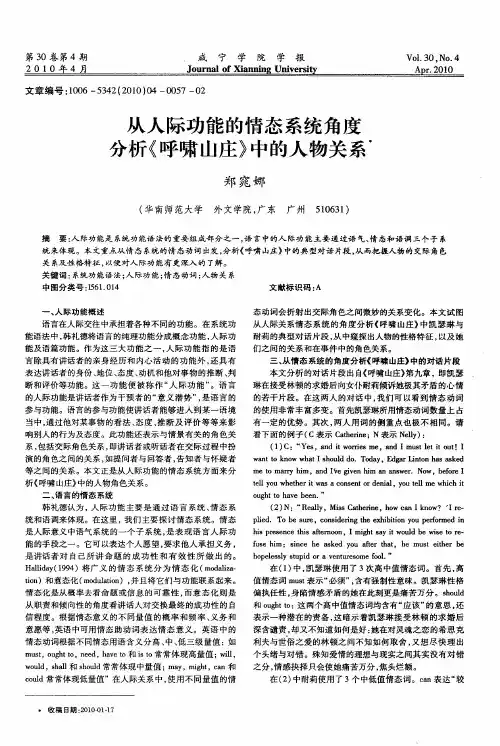
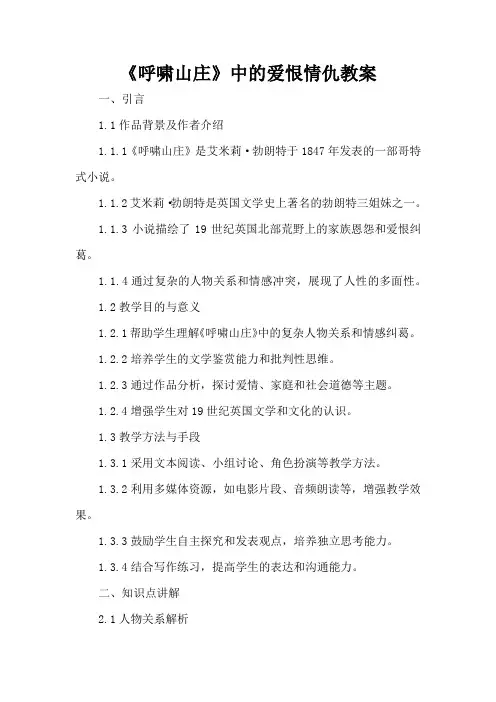
《呼啸山庄》中的爱恨情仇教案一、引言1.1作品背景及作者介绍1.1.1《呼啸山庄》是艾米莉·勃朗特于1847年发表的一部哥特式小说。
1.1.2艾米莉·勃朗特是英国文学史上著名的勃朗特三姐妹之一。
1.1.3小说描绘了19世纪英国北部荒野上的家族恩怨和爱恨纠葛。
1.1.4通过复杂的人物关系和情感冲突,展现了人性的多面性。
1.2教学目的与意义1.2.1帮助学生理解《呼啸山庄》中的复杂人物关系和情感纠葛。
1.2.2培养学生的文学鉴赏能力和批判性思维。
1.2.3通过作品分析,探讨爱情、家庭和社会道德等主题。
1.2.4增强学生对19世纪英国文学和文化的认识。
1.3教学方法与手段1.3.1采用文本阅读、小组讨论、角色扮演等教学方法。
1.3.2利用多媒体资源,如电影片段、音频朗读等,增强教学效果。
1.3.3鼓励学生自主探究和发表观点,培养独立思考能力。
1.3.4结合写作练习,提高学生的表达和沟通能力。
二、知识点讲解2.1人物关系解析2.1.1主要人物包括凯瑟琳、希斯克利夫、埃德加等。
2.1.2人物之间的关系错综复杂,充满爱恨纠葛。
2.1.3通过人物关系分析,揭示小说的核心冲突和主题。
2.1.4人物性格和命运的对比,反映了不同社会阶层和价值观的冲突。
2.2情感冲突分析2.2.1爱情是小说中最主要的情感冲突,表现为凯瑟琳和希斯克利夫之间复杂的爱情关系。
2.2.2家庭关系中的爱与恨,如凯瑟琳与埃德加的婚姻。
2.2.3个人情感与社会道德的冲突,如希斯克利夫的复仇行为。
2.2.4情感冲突的深层原因,包括阶级差异、人性弱点等。
2.3文学手法与风格2.3.1采用多重视角叙事,增强故事的层次感和深度。
2.3.2运用象征和隐喻,如自然环境的描绘反映了人物心理状态。
2.3.3语言风格多变,既有抒情的描写,也有讽刺和幽默的元素。
2.3.4情节安排紧凑,悬念迭起,吸引读者的注意力。
三、教学内容3.1文本阅读与分析3.1.1分章节阅读小说,理解每个章节的主要内容和情感走向。
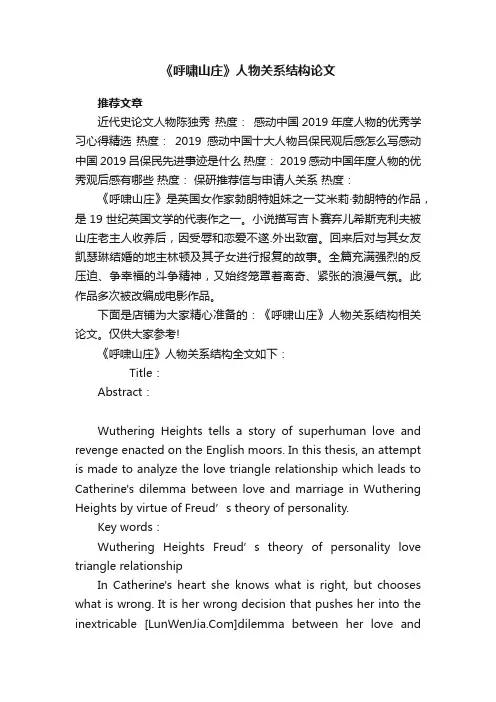
《呼啸山庄》人物关系结构论文推荐文章近代史论文人物陈独秀热度:感动中国2019年度人物的优秀学习心得精选热度:2019感动中国十大人物吕保民观后感怎么写感动中国2019吕保民先进事迹是什么热度: 2019感动中国年度人物的优秀观后感有哪些热度:保研推荐信与申请人关系热度:《呼啸山庄》是英国女作家勃朗特姐妹之一艾米莉·勃朗特的作品,是19世纪英国文学的代表作之一。
小说描写吉卜赛弃儿希斯克利夫被山庄老主人收养后,因受辱和恋爱不遂.外出致富。
回来后对与其女友凯瑟琳结婚的地主林顿及其子女进行报复的故事。
全篇充满强烈的反压迫、争幸福的斗争精神,又始终笼罩着离奇、紧张的浪漫气氛。
此作品多次被改编成电影作品。
下面是店铺为大家精心准备的:《呼啸山庄》人物关系结构相关论文。
仅供大家参考!《呼啸山庄》人物关系结构全文如下:Title:Abstract:Wuthering Heights tells a story of superhuman love and revenge enacted on the English moors. In this thesis, an attempt is made to analyze the love triangle relationship which leads to Catherine's dilemma between love and marriage in Wuthering Heights by virtue of Freud’s theory of personality.Key words:Wuthering Heights Freud’s theory of personality love triangle relationshipIn Catherine's heart she knows what is right, but chooses what is wrong. It is her wrong decision that pushes her into the inextricable []dilemma between her love andmarriage; it is her wrong choice that plunges the two families into chaos. In the mind, she is truly out of her way.According to Sigmund Freud(1856—1939), the structure of the mind or personality consists three portions: the id, the ego, and the sup erego.“The id, which is the reservoir of biological impulses, constitutes the entire personality of the infant at birth. Its principle of operation, to guard the person from painful tension, is termed the pleasure principle. Inevitable frustrations of the id, together with what the child learns from his encounters with external reality, generate the ego, which is essentially a mechanism to minimize frustrations of the biological drives in the long run. It operates according to the reality principle … []The superego comprises the conscience, a partly conscious system of introjected moral inhibitions, and the ego-ideal, the source of the individual's standards for his own behavior. Like external reality, from which it derives, the superego often presents obstacles to the satisfaction of biological drives.”“In the mentally healthy person, these three systems form a unified and harmonious organization. Conversely, when the three systems of personality are at odds with one another the person is said to be maladjusted.” Here Catherine's tragic psychological process may be well illustrated by Freudian psychoanalysis.“I cannot express it; but surely you and everybody have a notion that there is, or should be, an existence of yours beyond you. What were the use of my creation, if I were entirely contained here?” Catherine's strange words reflect that the intelligent Emily Bronte had been earlier pondering over a same question in her work. What on earth is“the existence of Catherine's beyond Catherine”?Here we may believe that Heathcliff stands for Catherine's instinctual nature and the strongest desire—her “id” in the depths of her soul; Edgar, her ideal “superego”, represents another part of her personality: the well-bred gracefulness and the superiorit y of a wealthy family; and she, herself is the “ego” tortured by the friction between the two in the disharmonious situation.In the light of Freud's theory of personality, “the superego is the representation in the personality of the traditional values and ideals of society as they are handed down from parents to children.” Catherine's choice of Edgar as her husband is to satisfy her ideal “superego” to get wealth and high social position, which are the symbol of her class, on the basis of the education by her family and reality from her early childhood. She is a Miss of a noble family with a long history of about three hundred years. Only the marriage well-matched in social and economic status could be a satisfaction for all: her family, the society and even her practical self. “It would degrade me to many Heathcliff now ... if Heathcliff and I married, we should be beggars?” This is her actual worry for her future. Catherine yields to the pressure from her brother, and alike, in truth, she is yielding to the moral rules of society, without the approval and identification of which, she could not live a better life or even exist in it at all.However, Catherine underestimates what her other more intrinsic self would have effect on her. The most remarkable claim by Catherine herself may be the best convincing evidence to distinguish the different roles of Heathcliff and Edgar—her “id” and her “superego”:“My great miseries in this world have been Heathcliff's miseries, and I watched and felt each from the beginning: mygreat thought in living is himself. If all else perished, and he remained, I should still continue to be; and if all else perished, and he was annihilated, the universe would turn to a mighty stranger: I should not seem a part of it. My love for Linton is like foliage in the woods: time will change it. I'm well aware, as winter changes the trees. My love for Heathcliff resembles the eternal rocks beneath: a source of little visible delight, but necessary. Nelly, I'm Heathcliff! He's always, always in my mind: not as a pleasure and more than I am always a pleasure to me, but as my own being. So don't talk of our separation again: it is impracticable.”It was a happy thought to make her love the kind, wealthy, weak, elegant Edgar, yet in submission to her superego to oppose against her id, she would fall into a loss of the self. Since the id is the most primitive basis of personality, and the ego is formed out of the id, Catherine's life depends wholly on Heathcliff, as the whole connotation and truth of her life in the cosmic world, for its existence and further more for the significance of her existence. Heathcliff is the most necessary part of her being. She marries Edgar, but Heathcliff still clutches her soul in his passionate embrace. Although she is a bit ashamed of her early playmate, she loves him with a passionate abandonment that sets culture, education, the world at defiance. Catherine's wrong choice for marriage violates her inner desires. The choice is a victory for self-indulgence—a sacrifice of primary to secondary things. And she pays for it.On one hand, Catherine doesn't find the heavenly happiness she was longing for. Though as a girl “full of ambition”and “to be the greatest woman of the neighborhood” would be her pride, the enviable marriage could only flatter her vanity for asecond. After her marriage, the comfortable and peaceful life in the Grange was just a monotonous and lifeless confinement of her soul. She feels chocked by the artificial and unnatural conditions in the closed Thrushcross Grange— a world in which the mind has hardened and become unalterable.“If I were in heaven, Nelly, I should be extremely miserable. ” Catherine eventually knows that the Lintons' heaven is not her ideal heaven. She and Heathcliff really possess their common heaven. Just as Catherine says,“Whatever our souls are made of, his and mine are the same; and Linton's is as different as a moonbeam from lightning, or frost from fire.”Catherine doesn't want to live in the Lintons' heaven; on the other hand, she has lost her own paradise that she ever had with Heathcliff on the bare hard moor in their childhood. The deepest bent of her nature announces her destiny—a wanderer between the two worlds. When she is alive, she occupies a position midway between the two. She belongs in a sense to both and is constantly drawn first in Heathcliff's direction, then in Edgar's, and then in Heathcliff's again and at last she loses herself completely. Her childish illusion to use her husband's money to aid Heatllcliff to rise out of her brother's power has vanished in thin air. And her constant struggle to reconcile two irreconcilable ways of life is in vain too, which only caused more disorder in the two worlds and in herself as well.In Freudian principles, should the ego continually fail in its task of satisfying the demands of the id, these three factors together—the painful repression of the id's instinctual desires, the guilt conscience of revolt against the superego's wishes, and the frustration of failure in finding outlets in the external world- would contribute to ever-increasing anxiety. The anxiety piles upand finally overwhelms the person. When this happens, the person is said to leave hallucinatory wish-fulfillment, then a nervous radical breakdown, and in the end may finish the person off. Catherine is destroyed into psychic fragmentation by the friction between the two. At the height of her Edgan-Heathcliff torment, Catherine lies delirious on the floor at the Grange. She dreams that she is back in her own old bed at Wuthering Heights “enclosed in the oak-paneled bed at home, and my heart ached with some great grief…my misery arose from the separation that Hindley had ordered between me and Heathcliff.”Still dreaming, she tries to push back the panels of the oak bed, only to find herself touching the table and the carpet at the Grange:“My late anguish was swallowed in a paroxysm of despair. I cannot say why I was so wildly wretched ... and my all in all, as Heathcliff was at that time, and been converted at a stroke into Mrs. Linton...the wife of a stranger: an exile, and outcast.” She attempts to forget the lengthy days of years of life without her soul even in her temporary derangement.“Most strangely, the whole last seven years of my life grew a blank! I did not recall that they had been at all.” Her mental and physical decay rapidly leads to the body's mortal end. She dies and seems to have none into perfect peace.But even after her death, she is still a wandering ghost. In Chapter 3, Lockwood, the lodger in Catherine's oak-paneled bed at Wuthering Heights dreams about the little wailing ghost: “The intense horror of nightmare came over me: I tried to draw back my arm, but the hand clung to it, and a most melancholy voice sobbed, ‘Let me in-Let me in’.‘ Who are you?’…‘Catherine Linton’, it replied, shiveringly…‘I'm come home: I'd lost my way on the moor!’…Terror made me cruel; andfinding it useless to attempt shaking the creature off, I pulled its wrist on to the broken pane, and rubbed it to and fro till then blood ran down and soaked the bedclothes: still it wailed, ‘Let me in!’…it is twenty years, twenty years. I've been a waif for twenty years!”Catherine aspires to be back in her heaven even being a spirit. But leer self-deceptive decision has made her fall from her and Heathcliff's heaven full of demonic love and her never docile or submissive nature has drawn her out of her and Edgar's heaven filled with civilized emptiness in the meantime. She pushes herself into her tragedy, the endless dilemma between her love and marriage, which won't end up with her death.Bibliography:1.Bronte Emily,Wuthering Heights,Beijing:Foreign Language T eaching and Research Press,London:Oxford University Press 19952.Freud Sigmund,Interpretation of Dreams,Beijing:Foreign Language Teaching and Research Press 20013.Travis Trysh,Heathcliff and Cathy,the Dysfunctional Couple,The Chronicle of Higher Education,Washington,20014.Steinitz Rebecca,Diaries and Displacement in Wuthering Heights,Studies in the Novel,Denton,20005.方平译,《呼啸山庄》,上海:上海译文出版社,20006.弗洛伊德,《精神分析引论新编》,北京:商务印书馆,19967.高宣扬,《弗洛伊德传》,北京:作家出版社,19868.陆扬,《精神分析文论》,济南:山东教育出版社,20019.扬静远译,《勃朗特姐妹研究》,北京:中国社会科学出版社,198310.凌晨光,《当代文学批评学》,济南:山东大学出版社,2001。



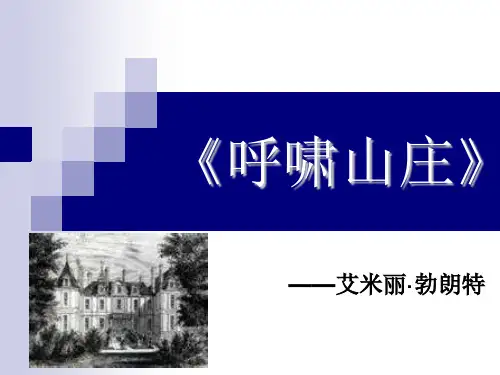

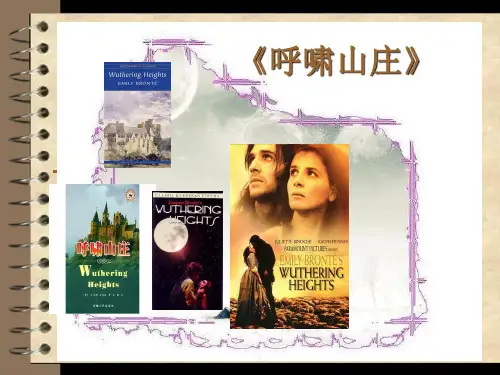

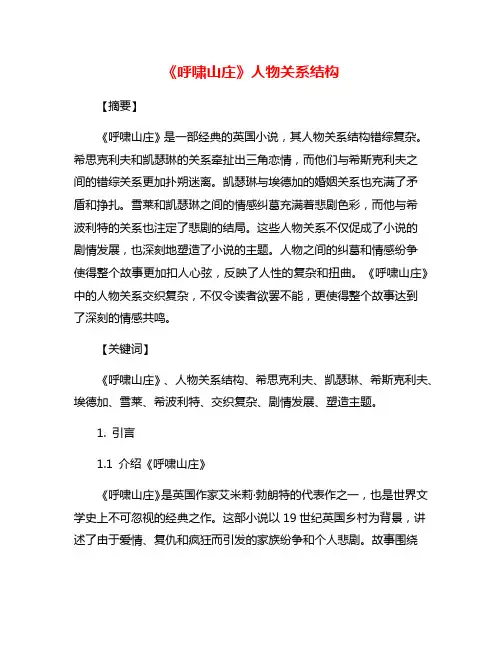
《呼啸山庄》人物关系结构【摘要】《呼啸山庄》是一部经典的英国小说,其人物关系结构错综复杂。
希思克利夫和凯瑟琳的关系牵扯出三角恋情,而他们与希斯克利夫之间的错综关系更加扑朔迷离。
凯瑟琳与埃德加的婚姻关系也充满了矛盾和挣扎。
雪莱和凯瑟琳之间的情感纠葛充满着悲剧色彩,而他与希波利特的关系也注定了悲剧的结局。
这些人物关系不仅促成了小说的剧情发展,也深刻地塑造了小说的主题。
人物之间的纠葛和情感纷争使得整个故事更加扣人心弦,反映了人性的复杂和扭曲。
《呼啸山庄》中的人物关系交织复杂,不仅令读者欲罢不能,更使得整个故事达到了深刻的情感共鸣。
【关键词】《呼啸山庄》、人物关系结构、希思克利夫、凯瑟琳、希斯克利夫、埃德加、雪莱、希波利特、交织复杂、剧情发展、塑造主题。
1. 引言1.1 介绍《呼啸山庄》《呼啸山庄》是英国作家艾米莉·勃朗特的代表作之一,也是世界文学史上不可忽视的经典之作。
这部小说以19世纪英国乡村为背景,讲述了由于爱情、复仇和疯狂而引发的家族纷争和个人悲剧。
故事围绕着希斯克利夫、凯瑟琳和希思克利夫这几个主要人物展开,展现出了深厚的人性复杂性和悲剧性。
通过深入分析《呼啸山庄》中各个人物之间的复杂关系,我们可以更深入地理解这部小说的精髓所在,以及作者对人性、道德和社会现实的思考和反思。
1.2 概述人物关系结构《呼啸山庄》是英国作家Emily Bronte的经典小说,讲述了希斯克利夫和凯瑟琳之间错综复杂的爱恨情仇,以及他们与其他人物之间纷繁复杂的人际关系。
小说中的人物关系结构是整个故事的核心,是推动情节发展和展现主题的关键。
在《呼啸山庄》中,人物关系错综复杂、纷繁复杂。
希思克利夫和凯瑟琳之间的复杂爱恨情仇是整个故事的主线,他们之间的关系充满着激烈的情感冲突和离奇的命运交错。
希思克利夫与凯瑟琳的爱情纠葛也牵扯出了希斯克利夫的身世秘密,进一步加剧了他们之间的关系复杂度。
凯瑟琳与希思克利夫之外的其他人物也在人物关系中扮演着重要角色。
呼啸山庄:爱与痛苦的边界概述《呼啸山庄》是英国作家艾米莉·勃朗特创作的一部经典小说。
该小说以复杂的人物关系和情感冲突为主线,描绘了19世纪英国北部庄园生活中爱与痛苦的边界。
1.人物关系与情感1.1 凯瑟琳与希斯克利夫凯瑟琳和希斯克利夫是小说中最重要的角色之一。
他们从童年时期开始就建立了深厚的情感连接,然而他们之间存在着贵族和仆人之间不可逾越的鸿沟。
这种不平等导致了他们最终无法在一起,使得他们的爱变成痛苦。
1.2 凯瑟琳与埃德加凯瑟琳被迫与思想迥异的埃德加结婚。
尽管埃德加对她非常关心,但凯瑟琳内心却始终对充满野性的希斯克利夫念念不忘。
这种错位的情感使得她陷入了痛苦与折磨之中。
1.3 希斯克利夫与伊莎贝拉希斯克利夫为了报复凯瑟琳嫁给埃德加,决定追求伊莎贝拉。
然而,这段关系只是建立在仇恨和复仇的基础上,最终导致了伊莎贝拉的痛苦和悲伤。
2.社会阶级与爱情2.1 社会阶级对爱情的限制《呼啸山庄》揭示了19世纪英国社会等级制度对个人自由选择爱情的限制。
凯瑟琳和希斯克利夫之间的阶级差异成为他们无法在一起的最主要原因。
2.2 爱情对社会阶级的挑战尽管面临着重重困难,但凯瑟琳和希斯克利夫仍然试图跨越社会阶级束缚。
小说中描绘了他们不顾一切地追求爱情并与传统观念作斗争的勇气和决心。
3.痛苦与牺牲3.1 爱情的痛苦《呼啸山庄》展示了爱情带来的痛苦和折磨。
凯瑟琳和希斯克利夫之间的复杂情感,以及他们对彼此无法实现的渴望造成了深深的伤害。
3.2 牺牲与救赎小说中还存在一些角色通过牺牲自我来挽救他人或得到救赎的情节。
这种牺牲精神体现了爱与痛苦之间微妙而复杂的联系。
结论《呼啸山庄》通过描绘复杂的人物关系和摆脱社会阶级束缚寻求真爱所带来的痛苦,探索了爱与痛苦之间边界线上所存在的挣扎和冲突。
这部小说引发读者对于个人自由、社会等级制度和传统观念等话题的深思,并成为文学史上不可忽视的经典之作。